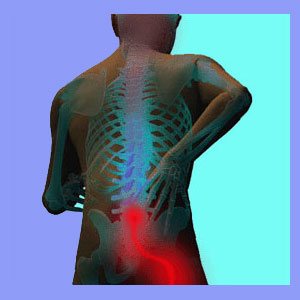
Sciatica in athletes can strike professional or amateur competitors in any sport or fitness pastime. In fact, active people often complain of buttocks, leg or foot pain that might actually interfere with active participation in their favorite athletic endeavors.
There are both anatomical and mindbody explanations for acute or chronic sciatica in athletic people of any age. Therefore, it is crucial to approach the topic with an objective viewpoint and complete understanding of all the potential causes and contributors to the current expression. Athletes rely on their bodies to perform upon command, which can cause substantial physical and psychoemotional stress. Due to this fact, accurate diagnosis of athletic-related sciatica might be a particularly difficult proposition to accomplish.
It is worth reminding the reader that true sciatica is always generated by a lumbar spinal problem that affects the nerve roots which go on to form the sciatic nerve lower in the anatomy. However, most sciatica pain syndromes are actually sourced by some nonspinal causation and are therefore best referred to as pseudo-sciatica. For the sake of this essay, we will cover both true and pseudo versions of sciatic nerve symptomologies.
Injury-Related Sciatica in Athletes
Athletic people are sometimes predisposed towards injury as inherent parts of their normal lives. This is especially true for athletes who participate in high-risk activities such as martial arts, American football, rugby, wrestling and other contact sports.
Trauma and repetitive strain can both lead to true and pseudo versions of sciatica. Injury is a common source of symptoms, as damage can occur to the spinal structures, the sciatic nerve itself, or to some muscular tissues, such as the piriformis, that may initiate symptoms.
If the lumbar spinal nerve roots are compressed, such as by an acute intervertebral herniation or a vertebral fracture, sciatica may ensue.
If muscular imbalance or injury occurs to the piriformis, then the entire sciatic nerve might suffer impingement.
Nonpenetrative trauma to the sciatica nerve itself is rare, but could potentially occur in extreme circumstance of bodily harm.
Repetitive strain is a controversial theory of pain, since although epidemic in presentation, many doctors disagree with the RSI diagnosis as being completely unscientific and logically unsound. After all, repetitive strain actually is used to build muscle and endurance in athletes, so it is difficult to image that the same activity would lead to serious injury. This issue is likely to remain hotly debated to decades to come.
Mindbody Sciatica in Competitors
Experts like Dr. John Sarno, Dr. Ira Rashbaum, Dr. Marc Sopher and many others have long said that the vast majority of sciatica syndromes are not related to any form of injury, degeneration or structural deficit. Instead, these pain conditions are generated as defense mechanisms to conceal troubling subconscious emotional issues. Many athletes have a problem subscribing to this theory, since the pain of sciatica seems so physical. Of course, this is the whole point. The pain is 100% physical, but the source may be linked to a psychological, and not a physical, process.
Competitive athletes place great pressures to themselves to perform, to excel and to work hard towards their goals. They also commonly suffer from emotional fear of injury or setback due to strict training regimens. Furthermore, athletic people are often perfect specimens of the personality type that is prone to developing mindbody pain problems. These people are self-motivated, driven, perfectionistic and disciplined to an extreme. All of these characteristics have been definitively proven to incite internal rage in the subconscious mind. It is this rage that can lead to the expression of pain, such as in the case of sciatica in athletes.
Although not universally applicable or accepted, this mindbody model of sciatica pain is gaining new supporters in the medical field, and in society as a whole, year over year. The mindbody theory of pain certainly does make sense when considering that so many athletes are finely tuned machines and perfect human specimens. It seems almost foolish to imagine that such honed bodies could possibly suffer chronic anatomically-motivated pain when they represent the height of athletic development and sports accomplishment.
Treating Sciatica in Athletes
Athletes rely heavily on their trainers, coaches and health service providers. However, it is obvious that in many cases, this strong dependency gets many athletes into trouble in terms of mistaken diagnosis and contraindicated treatment.
When seeking diagnosis for any sciatica syndrome, it is crucial to factor in all possible reasons for the pain to occur. It is vital to look for local injury, spinal structural problems, muscular concerns, systemic and disease-related issues and mindbody causations that may be present. This can be an exhaustive process and is surely beyond the scope of virtually any single doctor in the overly-compartmentalized modern medical system. This is the reason why so many sciatica conditions become long-term woes for athletes of all ages and activities. It is not that treatment has failed them time and time again. It is usually more logical to conclude that the diagnosis was flawed from day one, leading to therapy that had no hope of solving the true symptomatic source.
On a related note, it is common for serious athletes to deny the possible role of mindbody factors more than people in the general population. This seems to be caused by the idea that admitting to an emotional causation is akin to branding oneself with some deficiency or weakness. In reality, the opposite is actually the truth. Athletes who can find their psychoemotional weak points, and learn to resolve them, are truly at the top of their game, while those who continue to deny, suppress and repress emotional issues will always eventually be conquered by the voices inside their own heads.
Remember this crucial component of good health and you might just find the answer to your sciatica, as well as the direct path towards improved wellbeing in all aspects of life.





